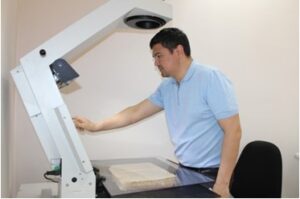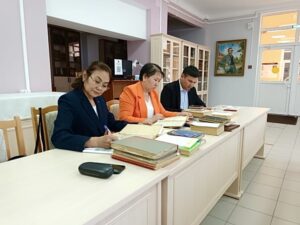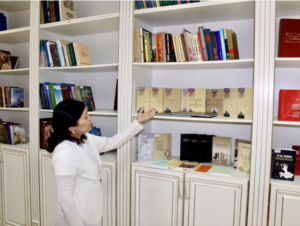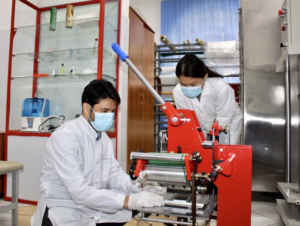Manuscripts and rare books - spiritual treasure of national history
Manuscripts and rare books represent the spiritual treasure of our national history. This invaluable heritage, narrating the centuries-old spiritual, political life, culture, and history of our country, has always been deeply cherished. Original manuscripts and rare editions are among the priceless and invaluable relics, composed in various languages, spanning a vast historical period from ancient times to the present day. The written legacy holds particular significance in recounting the historical narrative of our nation’s independence. However, the historical, literary, and cultural relics of the Kazakh people, who have contributed to a written heritage spanning 16 writing styles from ancient Turks to the contemporary era, have not been systematically collected, cataloged, described, or adequately translated into the Kazakh language.
President Kassym-Jomart Tokayev has placed special emphasis on the spiritual and cultural development of our nation in his annual messages. In his profound article “Independence is Dearer than Anything Else,” which resonates deeply with our people and illustrates confident strides toward a promising future, he has urged our country’s scholars to reexamine the history of the Kazakh people and craft a new academic narrative. “The world is changing not daily, but every hour. New challenges and requirements emerge in all spheres. Scientific discoveries propel humanity forward. It is a time that can only be surpassed by reason,” remarked the head of state in a subsequent message, underscoring numerous measures to be undertaken in science, education, and culture. By preserving and studying our cultural heritage and imparting it to our youth, we must showcase this legacy to the world.
In 2017, the “National Center of Manuscripts and Rare Books” was established with the objective of collecting manuscripts and rare books unveiling the secrets of our country’s early history and integrating them into scholarly circulation. Serving as the primary repository for valuable written sources located both within Kazakhstan and abroad and pertaining to our nation’s history, the National Center facilitates their collection, preservation, research, translation, and dissemination to future generations through scholarly circulation.
During the center’s inauguration year, the then-Chairman of the Senate of the Parliament of the Republic of Kazakhstan, Kassym-Jomart Tokayev, now the head of state, made a special visit to acquaint himself with the gathered heritage. Witnessing our ancient spiritual legacy, he expressed gratitude for the accomplished work and highly commended efforts to preserve our nation’s noble heritage for future generations, wishing success to the Center in its endeavors.
In the 1940s and 1960s, under the initiative of renowned academicians K. Satpayev, M. Auezov, and I. Kenesbaev, efforts began to amass valuable collections for the Foundation of the Academy of Sciences, persisting in this endeavor for many years. Through their extensive work, thousands of valuable manuscripts were amassed in this library. Additionally, scientists such as A. Divaev, A. Margulan, Sh. Kusainov, M. Khakimzhanova, F. Gabitova, I. Temirgaliev, and K. Kantarbaev were involved in collecting oral and written heritage.


Presently, the rare collection of the National Center of Manuscripts and Rare Books comprises approximately 2,000 items. Among them are over 300 rare works preserved in Arabic, Persian, and Turkic (Chagatai, Old Uzbek, Tatar) languages, authored by thinkers, sages, scientists, and other luminaries who contributed to the formation and evolution of Kazakh culture, literature, and book culture of other Turkic-speaking peoples, published during the XIX-XX centuries. Additionally, the collection includes works published in the 20th century in both Tote Jazu and Latin script, as well as publications by Kazakh educators and scientists, Western and Russian researchers, and codes of laws of the Russian Empire dating back to 1649, published during the reigns of Peter I and Catherine II. Furthermore, it houses statistical reviews dating from 1890 onwards, covering regions such as Akmola, Turgai, Syrdarya, Ural, Semipalatinsk, and Semirechensk, detailing developments in agriculture, demography, livestock breeding, and other areas. The collection also encompasses miniature books, ancient dictionaries, and encyclopedias.
Historically, Kazakhstan has accorded significant importance to its cultural heritage and written sources. In 1946, the Academy of Sciences was established in Kazakhstan, serving as the main scientific hub of the republic and coordinating research endeavors nationwide. Concurrently, the first president of the Academy of Sciences, the esteemed academician and statesman Kanysh Satbayev, spearheaded the initiative to collect ancient manuscripts and books. Through the concerted efforts of prominent scientists of that era, a unique rare collection was assembled. Since then, dedicated efforts to collect and preserve written heritage have commenced in all libraries and scientific institutions throughout the republic.

While Kazakhstan has achieved commendable progress over the years of independence, numerous critical issues remain to be addressed. Education, science, and culture stand as pivotal sectors that propel us toward correct and swift development within the trajectory of global progress, while safeguarding our rich history and constructing our ideology correctly. The formation of an enlightened and patriotic society hinges directly on education and culture.
Today, we will delve into the handwritten and book collections of our historical homeland. It is well-established that manuscripts from ancient times preserve comprehensive information about their era, covering a spectrum of topics including politics, economics, geography, history, and culture. During the Soviet era, greater attention was devoted to ancient Eastern manuscripts, with intensive research and careful preservation efforts. Today, libraries, archives, universities, museums, and other institutions house their own collections of manuscripts and rare books. However, the conditions of these collections often fall short of modern storage standards, and professional restoration and digitization efforts are insufficient. A centralized system for manuscript and rare book collection, examination, and acquisition has yet to be established nationwide. Additionally, regulatory legal frameworks governing these processes are lacking, leading to the gradual disappearance of many historical sources due to improper storage practices and inadequate restoration efforts.
Regrettably, Kazakhstan currently lags behind other nations on the global stage concerning the development, popularization, preservation, and utilization of manuscripts and rare books.
HISTORY OF THE NATIONAL CENTER OF MANUSCRIPTS AND RARE BOOKS
The Republican State Institution “National Center of Manuscripts and Rare Books” of the Ministry of Culture and Sports of the Republic of Kazakhstan (here in after referred to as the National Center) was established by Decree of the Government of the Republic of Kazakhstan dated May 31, 2017, No. 321. The official inauguration of the institution took place on June 10, 2017 (as part of the International Exhibition “EXPO-2017”).
The establishment was formed through reorganization and officially approved as a Republican State Institution. The current staff comprises 23 (twenty-three) units. This organization was established with the primary objective of searching, restoring, scanning, and preserving ancient manuscripts and rare books. The center is outfitted with cutting-edge technologies for restoration work and digitalization.
Despite its relatively modest size, the center employs highly skilled specialists in various fields. Among them are doctors of historical sciences, experts in Arabic studies, linguists specializing in ancient languages, and top-tier restoration professionals (educated in leading foreign centers). Presently, the Center has gained recognition on the international stage. It frequently hosts a multitude of scholarly events aimed at the preservation and promotion of this field (including conferences, roundtable discussions, exhibitions, seminars, master classes, and publication of materials).





The National Center consists of 5 departments:
Department for Organizing Research Work
Department of Restoration and Conservation
Department for Organizing Registration and Preservation Work, Exhibition, and Reading Rooms
Publishing Department
Administrative and Financial Department
Since its inception, the National Center has been situated within the premises of the National Archives of the Republic of Kazakhstan, on a rent-free basis. While the cohabitation of two or more organizations within the same building is not uncommon, it is considered unacceptable for other entities to operate within a building designated as a protected (secure) facility and recognized as the primary archival institution of the country. The National Archives has implemented a specific work schedule on weekdays from 09:00 to 18:00, with the entire facility closed on weekends and holidays. Moreover, there are certain restrictions for visits by foreign nationals. These conditions are dictated by the legislation of the Republic of Kazakhstan, and adherence to them is mandatory due to the storage of highly valuable and classified documents.
On the other hand, the National Center, lacking authorization to utilize the building, faces limitations in conducting its activities to the same extent as its domestic and international counterparts. Considering global practices, similar centers function as cultural hubs promoting the heritage of their respective countries. To achieve this goal, the National Center’s premises should be accessible to all citizens, including foreign visitors. Additionally, the building should be meticulously planned and equipped with state-of-the-art technological facilities.
The primary objectives of the National Center include:
Identification, collection, storage, restoration, research, integration into scholarly circulation, and provision to users of manuscripts and rare books, as well as documents (copies) located within our country and abroad and pertaining to the history of Kazakhstan.
Establishment of a centralized repository of rare manuscripts and books of the Republic of Kazakhstan and the creation of a database titled “Rare Manuscripts and Books of Kazakhstan.”
Identification and preservation of ancient manuscripts and books relevant to the history of Kazakhstan. The center employs qualified historians, orientalists, and specialists proficient in Arabic, Persian, Tote Jazu, Khadim, Chinese, and other languages. The fund is continuously augmented by acquiring original valuable manuscripts and their copies.
The Academic Council serves as a collegial advisory body for providing organizational support for scientific research and over seeing the implementation of planned activities. The composition, tasks, powers, and regulations of the Academic Council are stipulated in the Charter of the Republican State Institution “National Center of Manuscripts and Rare Books.” The activities of the Academic Council of the National Center are conducted in accordance with the current “Regulations on the Academic Council.”

